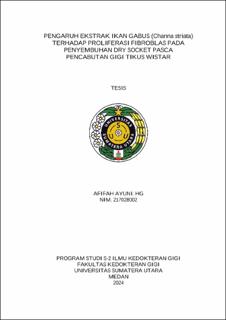| dc.description.abstract | Background: Dry socket is a complication that arises following tooth extraction, characterized by heightened fibrinolysis activity leading to the breakdown of the blood clot within the socket post-extraction. This phenomenon triggers prolonged inflammation, intense pain, and delayed wound healing. The snakehead fish, scientifically known as Channa striata, is a natural resource rich in albumin, Zn, Cu, Fe and amino acid, believed to expedite the healing process of dry socket by promoting fibroblast proliferation. Aim: The primary objective of this research is to evaluate the impact of orally administering snakehead fish extract at varying doses 45 mg/kgBW, 90 mg/kgBW, 180 mg/kgBW and 360 mg/kgBW on the healing of dry socket wounds. Methods: This study employed an in vivo experimental approach utilizing a posttest only control group design. Forty-five wistar rats were allocated into five groups: the snakehead fish extract group receiving doses at 45 mg/kgBW, 90 mg/kgBW, 180 mg/kgBW, 360 mg/kgBW, along with a negative control group. The extraction of the lower left incisor was followed by the induction of dry socket using adrenaline delivered through a paper point. Assessments of clinical wound closure, fibroblast proliferation, as well as PDGF-BB and TGF-β1 expression were conducted on days 3, 7, and 14. Result: Our findings showed significant increase in socket wound closure, fibroblast proliferation, and PDGF-BB expression (p<0.05). Conclusion: The introduction of snakehead fish extract has the potential to accelerate the healing process of dry socket wounds by augmenting the fibroblast numbers. | en_US |


